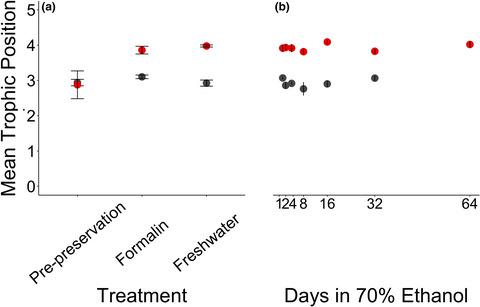当前位置:
X-MOL 学术
›
Ecol. Evol.
›
论文详情
Our official English website, www.x-mol.net, welcomes your
feedback! (Note: you will need to create a separate account there.)
Fluid‐preserved fishes are one solution for assessing historical change in fish trophic level
Ecology and Evolution ( IF 2.3 ) Pub Date : 2020-11-25 , DOI: 10.1002/ece3.7061 Rachel L Welicky 1, 2 , Terry Rolfe 3 , Karrin Leazer 1 , Katherine P Maslenikov 1, 4 , Luke Tornabene 1, 4 , Gordon W Holtgrieve 1 , Chelsea L Wood 1
中文翻译:

液体保存鱼是评估鱼类营养水平历史变化的一种解决方案
更新日期:2021-01-08
Ecology and Evolution ( IF 2.3 ) Pub Date : 2020-11-25 , DOI: 10.1002/ece3.7061 Rachel L Welicky 1, 2 , Terry Rolfe 3 , Karrin Leazer 1 , Katherine P Maslenikov 1, 4 , Luke Tornabene 1, 4 , Gordon W Holtgrieve 1 , Chelsea L Wood 1
Affiliation

|
- There are few resources available for assessing historical change in fish trophic dynamics, but specimens held in natural history collections could serve as this resource. In contemporary trophic ecology studies, trophic and source information can be obtained from compound‐specific stable isotope analysis of amino acids of nitrogen (CSIA‐AA‐N).
- We subjected whole Sebastes ruberrimus and Clupea pallasii to formalin fixation and 70% ethanol preservation. We extracted tissue samples from each fish pre‐fixation, after each chemical change, and then in doubling time for 32–64 days once placed in the final preservative. All samples were subjected to CSIA‐AA‐N, and their glutamic acid and phenylalanine profiles and associated trophic position were examined for differences over time by species.
- Glutamic acid and phenylalanine values were inconsistent in direction and magnitude, particularly during formalin fixation, but stabilized similarly (in 70% ethanol) among conspecifics. In some cases, the amino acid values of our final samples were significantly different than our initial pre‐preservation samples. Nonetheless, significant differences in glutamic acid, phenylalanine, and estimated trophic position were not detected among samples that were in 70% ethanol for >24 hr.
- Our results suggest that the relative trophic position of fluid‐preserved specimens can be estimated using CSIA‐AA‐N, and CSIA‐AA‐N estimates for fluid‐preserved specimens should only be reported as relative differences. Timelines of trophic position change can be developed by comparing specimens collected at different points in time, revealing trophic information of the past and cryptic ecosystem responses.
中文翻译:

液体保存鱼是评估鱼类营养水平历史变化的一种解决方案
可用于评估鱼类营养动态历史变化的资源很少,但自然历史收藏中的标本可以作为这种资源。在当代营养生态学研究中,营养和来源信息可以通过氮氨基酸的化合物特异性稳定同位素分析(CSIA-AA-N)获得。
我们对整个红鳝和鳅鱼进行福尔马林固定和 70% 乙醇保存。我们从每条鱼预固定、每次化学变化后提取组织样本,然后在放入最终防腐剂后在 32-64 天的倍增时间内提取组织样本。所有样品均接受了 CSIA-AA-N 检测,并检查了它们的谷氨酸和苯丙氨酸谱以及相关的营养位置随时间的不同物种的差异。
谷氨酸和苯丙氨酸值在方向和大小上不一致,特别是在福尔马林固定期间,但在同种中类似地稳定(在70%乙醇中)。在某些情况下,我们最终样品的氨基酸值与我们最初的预保存样品显着不同。尽管如此,在 70% 乙醇中浸泡超过 24 小时的样品中,未检测到谷氨酸、苯丙氨酸和估计营养位置的显着差异。
我们的结果表明,可以使用 CSIA-AA-N 来估计液体保存标本的相对营养位置,并且液体保存标本的 CSIA-AA-N 估计值只能报告为相对差异。通过比较不同时间点收集的标本,可以制定营养位置变化的时间表,揭示过去的营养信息和神秘的生态系统反应。











































 京公网安备 11010802027423号
京公网安备 11010802027423号